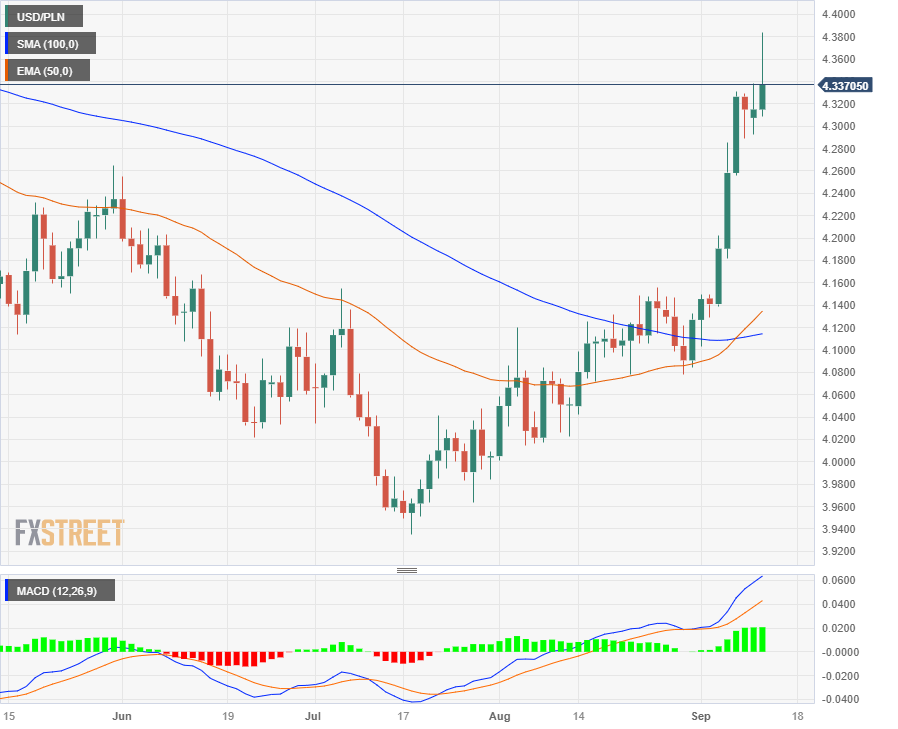- Analytics
- News and Tools
- Market News
- USD/PLN taps 4.38 as Poland threatens to extend Ukgraine grain embargo
USD/PLN taps 4.38 as Poland threatens to extend Ukgraine grain embargo
- Polish Zloty swoons on Ukraine grain spat.
- The bad news is accumulating for the PLN, which is still reeling from surprise rate cuts.
- Polish grain bans from Ukraine to face legal contention.
The USD/PLN has tipped into six-month highs near 4.3850 as the Polish Zloty (PLN) continues to sag against the Greenback (USD) following agriculture comments from Polish Prime Minister Mateusz Morawiecki, who is threatening to extend Poland’s embargo on Ukrainian corn, wheat, sunflower, and canola.
Early Tuesday saw another test for the PLN after Prime Minister Mateusz Morawiecki announced that he had formally requested that the European Commission, the executive arm of the European Union (EU), extend current restrictions on the volume of Ukrainian agricultural products that are allowed to cross the border into Poland.
The ruling Law & Justice party of Poland, a far-right ultra-nationalist party, is courting the farm vote ahead of the general election due to begin October 15th. Prime Minister Mateusz Morawiecki declared on the app formerly known as Twitter that, “Poland will not allow Ukraine grain to flood us”. The Polish Prime Minister telegraphed that Poland would continue to keep grain at the border regardless of the Commission’s decision, continuing on the social media app, “Regardless of the decisions of the clerks in Brussels, we will not open up our borders.”
Poland and several other regional neighbors all agreed on an EU embargo on grains produced by Kyiv from April until September 15th in an effort to prevent knock-on market effects on their farmers. Russia’s blockade on Ukrainian exports has left Ukraine with more grains than its domestic market can absorb.
EU Agriculture Commissioner Janusz Wojciechowski, who is Poland’s former agriculture minister, announced on Tuesday that he was actively trying to extend the embargo.
Ukraine grains threaten Poland, says Polish Prime Minister
Ukraine’s Prime Minister Denys Shmygal has threatened legal action on the ban extension, citing potential violations of the General Agreement on Tariffs and Trade (GATT). The Prime Minister declared that Kyiv will seek World Trade Organization (WTO) arbitration to recover losses, citing that the embargo extension represents “political populism before the (Polish) elections”.
The Polish Zloty knocked lower on news of the agriculture spat, and the PLN is on pace for its biggest single-month decline since September of last year. The end of 2022 saw the PLN hit record historical lows, with a single Greenback (USD) able to purchase over 5 Zloty at the peak.
The grains groans follow closely on the heels of Poland’s recent Zloty headaches, sparked by an unexpected rate cut from the Polish National Bank (PNB). PNB Governor Adam Glapiński gave a surprise 0.75% rate cut despite inflation still clearing 10% in the Polish economy.
PNB Governor Adam Glapiński has come under fire for the move, being accused on multiple fronts of politically motivated banking policies. Glapiński, an open supporter of the Law & Justice party, has been accused of trying to bolster political support ahead of the general election next month by reducing borrowing and lending rates at the future expense of the domestic economy.
Further reading: Zloty crumbles on the back of PNB rate cut, inflation still over 10%
USD/PLN technical outlook
The Zloty continues to lose ground against the USD, and the USD/PLN pairing was knocked higher on Tuesday, cracking near-term highs around 4.3350. The pair briefly broke through the 4.3800 handle, and the floor is looking very far away. A significant bottom has been priced into July’s swing low near 3.9500, and any downside momentum sees dynamic support rising from a bullish inversion of the 50-day Exponential Moving Average (EMA) and 100-day Simple Moving Average (SMA).
The Zloty is looking incredibly over-extended against the Greenback, but significant macro conditions are breaking the technicals.
USD/PLN daily chart

USD/PLN technical levels
© 2000-2024. All rights reserved.
This site is managed by Teletrade D.J. LLC 2351 LLC 2022 (Euro House, Richmond Hill Road, Kingstown, VC0100, St. Vincent and the Grenadines).
The information on this website is for informational purposes only and does not constitute any investment advice.
The company does not serve or provide services to customers who are residents of the US, Canada, Iran, The Democratic People's Republic of Korea, Yemen and FATF blacklisted countries.
Making transactions on financial markets with marginal financial instruments opens up wide possibilities and allows investors who are willing to take risks to earn high profits, carrying a potentially high risk of losses at the same time. Therefore you should responsibly approach the issue of choosing the appropriate investment strategy, taking the available resources into account, before starting trading.
Use of the information: full or partial use of materials from this website must always be referenced to TeleTrade as the source of information. Use of the materials on the Internet must be accompanied by a hyperlink to teletrade.org. Automatic import of materials and information from this website is prohibited.
Please contact our PR department if you have any questions or need assistance at pr@teletrade.global.















